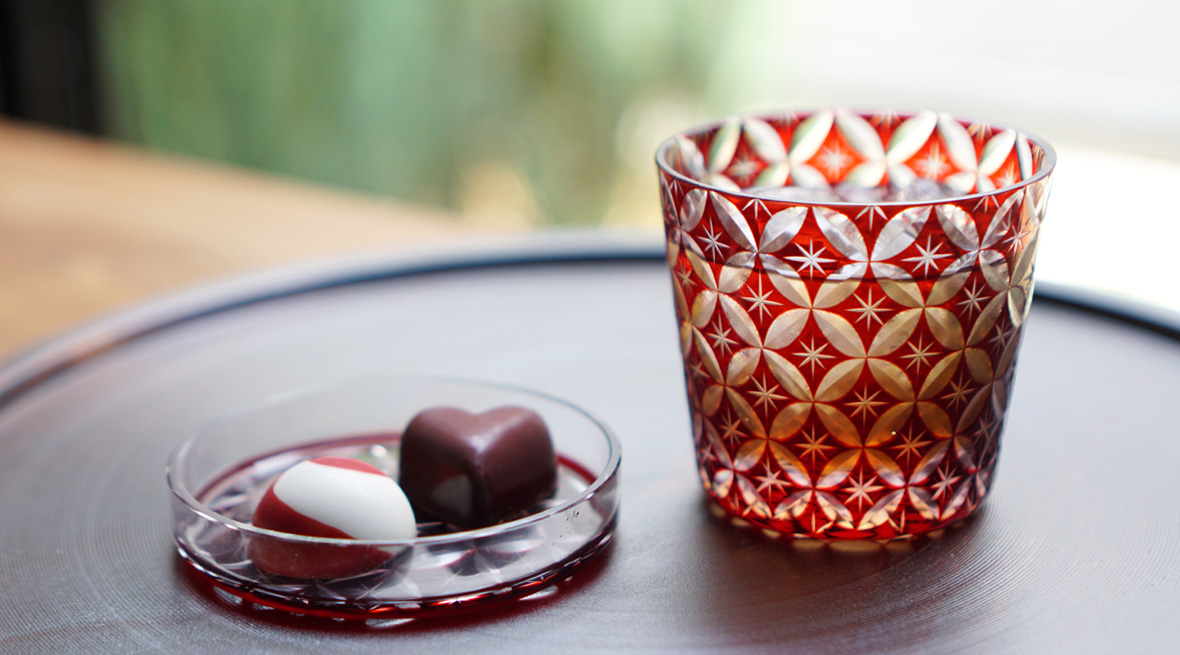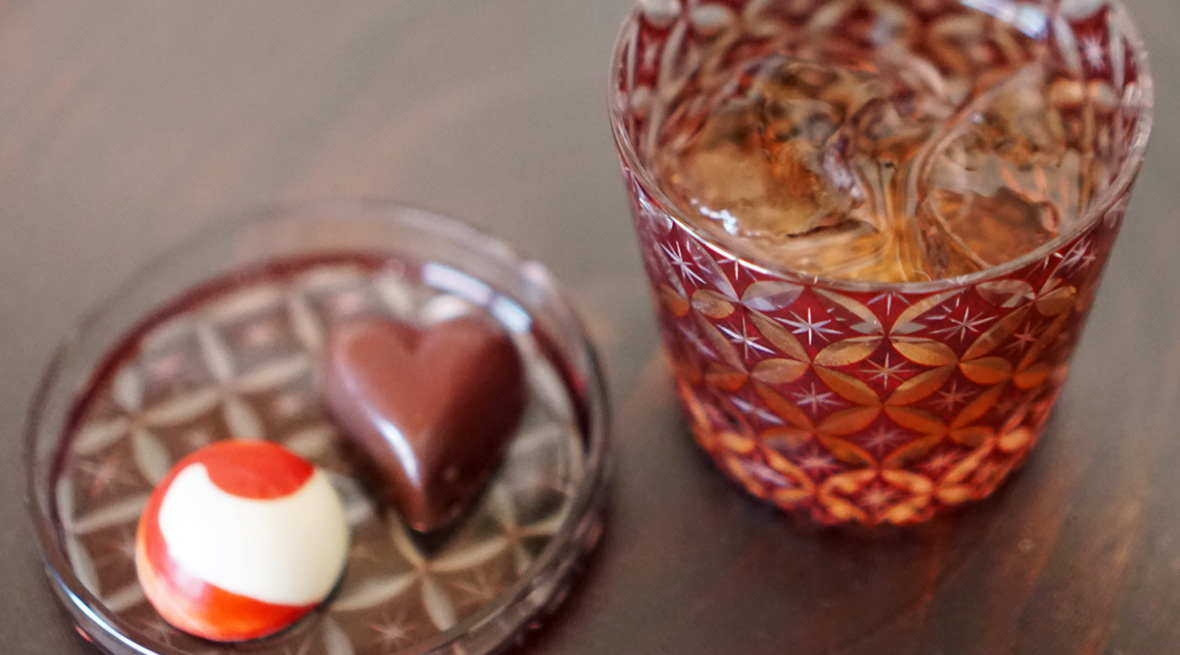| 商品名 | 生産国 | 素材 | サイズ・容量 |
|---|---|---|---|
| 廣田硝子 江戸切子 蓋ちょこ | 日本/東京 | ガラス | 約Φ80×H80mm(144ml) |
商品コード:889000051000/889000052000/889000062000/889000131000
- ホットドリンク用ではありません。
- 洗浄時は、中性洗剤などを使用してください。その際ガラスを傷つけるおそれのある研磨剤入りのスポンジ、金属たわし、クレンザーなどのご使用はお避けください。
- ガラスは急激な温度変化(特に急冷)で割れることがあります。ガラスが熱いうちに冷たいものを入れたり、濡れた所に置かないでください。
- 電子レンジ、食器洗浄器のご使用はお避けください。
- ※ こちらの商品は全て1点1点風合いが異なる商品です。商品に在庫がある場合、商品写真と実際お届けする商品の風合いは多少異なる場合がございますので、商品の特性をご理解いただいたうえ、ご注文ください。
- ※ 本商品は、実店舗(WISE・WISE tools)でも販売しております。在庫に限りがある為、システム管理上、実店舗での販売・在庫状況と本サイトの販売・在庫状況の確認に遅れが生じる場合があり、本商品をご購入後にキャンセル、または、お届け日が大幅に遅れる場合がございます。お客様にはご迷惑をおかけいたしますがご理解の程よろしくお願いいたします。
廣田硝子 Hirota Glass
- 江戸切子 / 東京都 墨田区 Edo Kiriko (cut glass) / Tokyo
- 1899年 東京にて創業
東京で最も歴史のある硝子メーカーの一つ。
近代にヨーロッパから伝わったガラス製造は、日本の美意識と融合し、日本独自のデザインを開花させました。
廣田硝子は、創業より社に伝わる貴重なデザイン資料を元に、江戸切子や吹き硝子など脈々と受け継がれる手仕事による伝統的製造を継承し、
現代のインテリアに調和するプロダクトを作り続けています。
|

-
江戸時代から続く切子硝子
江戸時代後期の天保5年(1834)、江戸の町でビードロ問屋を営む加賀屋久兵衛がガラスに切子(カット)を施したのが、江戸切子の始まりといわれています。
その後、明治から昭和初期にかけ、カット技術の進歩やガラス器の普及により切子硝子は発展し、昭和60年(1985)には東京都の、平成14年(2002)には国の伝統工芸品指定を受けます。カットされている文様はいずれもおめでたい意味を持っています。
是非、東京の誇る伝統工芸品を日常で使って、江戸の風情と美をお楽しみください。
When Shogun reined Japan, Tokyo was called “Edo”.
It is called the “Edo period (or era)” covering 265 years when the Shogun family continued the dynastic transfer of power. It is said that a glass wholesaler in Edo invented the first Edo Kiriko in 1834. Since the opening of the country (1868), cut glass has developed further with progress of technology and popularizing of glassware. In 1985 and 2002, Edo Kiriko was designated as Traditional Craft in Tokyo and in Japan, respectively. The patterns cut into glass have auspicious meanings.
Please enjoy the taste and beauty of Edo through use of Edo Kiriko in your daily life.

-
熟練した江戸切子職人の手技によって、あえてふつうの形のコップの上に美しさだけを考えて文様を配置しました。
底まで全部、縁もぎりぎりまで、光の図柄で埋め尽くされています。
Beautiful well-arranged patterns are engraved by an experienced craftsman on the surface of an ordinary glass cup.
All the surface, including the bottom and the very end of the edge, are filled with shining patterns.

-
角度によって実にさまざまに屈折し、万華鏡のような美しい世界が広がります。
Light is deflected in different directions depending on the angle of the surface, as if it were kaleidoscope views.

-
ゆるくかぶさるシャーレ上の蓋にも、しっかりカットが施されています。
蓋としてだけでなく受け皿として使ったり、豆皿のようにしてお使いいただけます。
華やかな江戸切子のグラスは、お正月やお祝いごとのハレの日の食卓にも、日々の暮らしの中の晩酌の1杯にも、特別なひと時をもたらしてくれます。
The surface of a lid is also engraved into several patterns.
The lid can be used as a small plate for serving foods and anything.
Edo Kiriko upgrade scenes of life, not only on celebrated occasions such as new year days and birthday but also on one day in daily life.

-
蓋ちょこの柄はどれも伝統的なカット文様をアレンジして、モダンな雰囲気に仕上げています。
“二重矢来”は2つの太さの矢来文様(斜めに交差する格子状の柄)を重ねた柄。小さなサイズで彫り込まれた可愛らしい印象です。
“七宝”は縁起のいい柄として昔から愛される文様です。真ん中に星のカットを施すことで、華やかで現代的な印象になりました。
“市松”は伝統模様としてよく目にする柄です。あえて細かいカットで刻み込むように繊細に表現しています。
“八重菊”は菊文様と呼ばれる星状のカットの外側に深いカットの花びらを足して、華やかで立体的な花柄に仕上げています。
The engraved patterns used for futa-choko (sake cups with a lid) are all based on traditional ones with contemporary arrangements.
The facet called “Nijuu Yarai - Double Yarai” is a traditional Japanese pattern that symbolizes crossed yarai (bamboo enclosure), which is regarded as an "amulet" to prevent external enemies and ward off evil.
“Shippo - Cloisonne” is also a popular traditional pattern. Engraved stars make a cup stylish and contemporary.
“Ichimatsu – Check” is widely prevalent even now. Not-colored facets are vertically and finely engraved to give an accent to the cup.
“Yae-giku – eightfold petals of chrysanthemum” is regarded as a noble pattern as chrysanthemum is used for the emblem of the emperor family. A glass with this pattern looks three-dimensional because of combination of petals with different-depth engraving.


